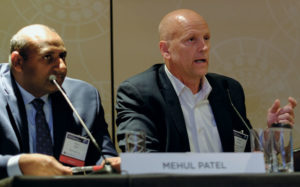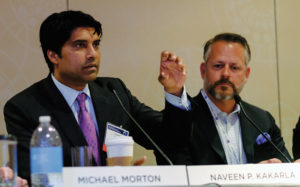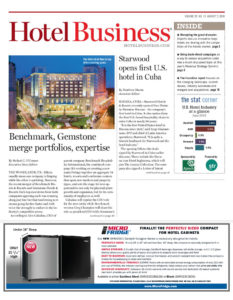NEW YORK—Franchising was a key topic during the recent NYU International Hospitality Industry Investment Conference here, bringing together a half-dozen industry players who gave varying perspectives on current approaches and issues. It was moderated by Joel M. Eisemann, chief development officer-The Americas for IHG.
According to Matt Wehling, SVP/Development-U.S. and Canada for Hilton Worldwide, the franchise landscape has changed in a variety of ways, driven by shifts in technology, OTAs, consolidation and government regulations, prompting owners, developers, franchisees and franchisors to reassess what’s important now.
“We do about 70% to 75% of our business with existing customers so they’ve kind of grown to know our system,” said Wehling. “There are issues that arise almost every time, typically around area of protection or restrictive area, sometimes around fees based on the type of deal, whether new construction, conversion. They may have different negotiations to them [e.g., PIPs vis-à-vis conversions].”

Best Western Hotels & Resorts’ VP/Owner Relations Michael Morton (right) stressed need to expand as NewcrestImage CEO Mehul Patel looks on. Photo: NYUSPS/David Gardiner
“I think the franchise world has to do with relationships,” said Mehul Patel, chairman/CEO of NewcrestImage. “I think if you have a great relationship with any of the brand partners, you tend to get a better deal on your franchise. We often remind the brand partners: We have this many brands with you, we’re paying this much royalty every year, we’re your customers. So this is where the negotiations start.”
NewcrestImage currently owns and operates 23 hotels with flags from Hilton, Marriott, Hyatt and IHG, and has 13 hotels under development that will open next year.
“Our focus is more lifestyle, extended-stay, and now our focus is mostly dual brands. We tend to do a lot of Marriott AC or Residence Inn; those two-brand combinations. Currently we have three in the works,” said Patel.
Barry A.N. Bloom, EVP/COO, of Xenia Hotels & Resorts, said the REIT is doing different kinds of deals.
“We’re focused really in three areas: premium full-service, where some large-scale deals are Marriott, Renaissance, Hilton, Westin, Hyatt. Also, a nice slice of our portfolio is in the lifestyle arena: Andaz, Autograph Collection, Kimpton. Another is urban select-service: Hampton Inn, Residence Inn, Hilton Garden Inn, Homewood Suites.”
Xenia plays in the top 25 markets in the U.S., as well as key leader destinations. “So, a little bit different strategy than some of the other REITs of similar size who focus on the top five to seven gateway markets; we like a broader approach,” said Bloom.
“We’ve bought four hotels, we’ve sold four hotels. We’ve invested about $380 million of new money and sold off about $258 million of recyclable assets. In total, we work with 16 brands, 75% of our portfolio is brand heavy,” he said.
Naveen Kakarla, president/CEO of HHM, operator of some 115 hotels in the U.S., noted companies and the franchising scene are consistently evolving.

HHM CEO Naveen Kakarla (left) makes a point while Hilton SVP/Development Matt Wehling listens. Photo: NYUSPS/David Gardiner
“In the ’80s, we started as an owner/operator and in the ’90s, we evolved into a group of companies that focused on ownership and operations and procurement, and we decided to silo the different parts of the business and scale them. We only operated for HT (REIT Hersha Hospitality Trust) and have now evolved into having about 65 hotels [not operated for HT]. We were primarily focused service or limited service and have grown to where we have 30 independents. We have small resorts, a luxury hotel in Philadelphia and have really expanded into everything from an 800-room hotel with 50,000 sq. ft. of meeting space to a 24-room hotel in an urban market,” said Kakarla. “So, we’ve taken on a lot of the different types of tiers from a franchising perspective.”
With seven brands now under the re-imaged membership organization that is Best Western Hotels & Resorts, Vib and Glo, a key go-forward for the global organization is “to get presence in markets where we know we are under-represented,” said Michael Morton, VP/owner relations. “So while a lot of the brands are now focused on second-tier or suburban markets, we’re focused on primary, first-tier destinations because we’re under-represented there and we’re doing a lot to allow Best Western to go in with some of its new brands.”
Morton said developers need to be aware of the growing number of brands, particularly in light of recent M&As, and the impact on areas of protection.
Changing industry dynamics also can affect long-standing models, Morton observed. “For a long time, we had a fixed-fee, per-room model. As an organization we realized that was not sustainable, so we’ve changed our fees; they’re still very competitive.”
How competition might shake out over the franchising universe also was a key topic, given Marriott International’s pending acquisition of Starwood Hotels & Resorts Worldwide, Inc. While not a done deal at press time, panelists considered it a major factor.
“I think overall it’s going to be good for the industry long term, especially the select-service segment. Companies like ours will benefit from it,” said Craig J. Aniszewski, EVP/COO of lodging REIT Summit Hotel Properties. “I think it’s actually going to catapult new brands, which could be good or could be bad, in competition in the market.”
Kakarla, whose company has product from both franchisors in a variety of markets, had concern for overlapping markets. “We have a Sheraton at Miami Airport. It has a lot of meeting space and 400 rooms. The airport has the full complement of Marriott representation. So where does the Sheraton fit within the Marriott family to the extent someone starts to believe it is of the Marriott family as opposed to a Starwood family that is separate from the Marriott family. I think we are going to have that type of conversation around what it means,” said Kakarla. “Yet, if you look at the dozen to 15 core or power brands and then look at the rest, there’s a real opportunity for Marriott to create some distinction without upsetting all of the owners, because it would lead to better overall lift for their system and all of the owners. Behind closed doors I could see a lot of ‘tweaking’ in order to create better differentiation in some of the markets like the one I mentioned.” HB

